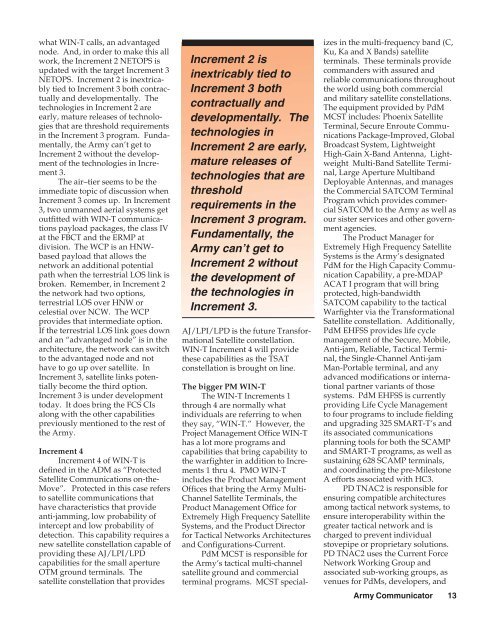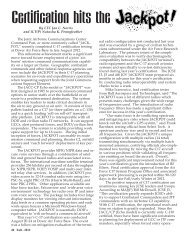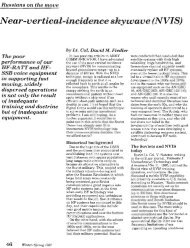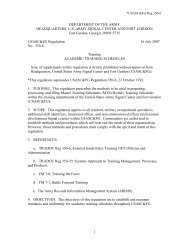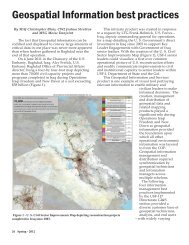AC Summer 08 WIN-T Online - United States Army Signal Center of ...
AC Summer 08 WIN-T Online - United States Army Signal Center of ...
AC Summer 08 WIN-T Online - United States Army Signal Center of ...
Create successful ePaper yourself
Turn your PDF publications into a flip-book with our unique Google optimized e-Paper software.
what <strong>WIN</strong>-T calls, an advantaged<br />
node. And, in order to make this all<br />
work, the Increment 2 NETOPS is<br />
updated with the target Increment 3<br />
NETOPS. Increment 2 is inextricably<br />
tied to Increment 3 both contractually<br />
and developmentally. The<br />
technologies in Increment 2 are<br />
early, mature releases <strong>of</strong> technologies<br />
that are threshold requirements<br />
in the Increment 3 program. Fundamentally,<br />
the <strong>Army</strong> can’t get to<br />
Increment 2 without the development<br />
<strong>of</strong> the technologies in Increment<br />
3.<br />
The air–tier seems to be the<br />
immediate topic <strong>of</strong> discussion when<br />
Increment 3 comes up. In Increment<br />
3, two unmanned aerial systems get<br />
outfitted with <strong>WIN</strong>-T communications<br />
payload packages, the class IV<br />
at the FBCT and the ERMP at<br />
division. The WCP is an HNWbased<br />
payload that allows the<br />
network an additional potential<br />
path when the terrestrial LOS link is<br />
broken. Remember, in Increment 2<br />
the network had two options,<br />
terrestrial LOS over HNW or<br />
celestial over NCW. The WCP<br />
provides that intermediate option.<br />
If the terrestrial LOS link goes down<br />
and an “advantaged node” is in the<br />
architecture, the network can switch<br />
to the advantaged node and not<br />
have to go up over satellite. In<br />
Increment 3, satellite links potentially<br />
become the third option.<br />
Increment 3 is under development<br />
today. It does bring the FCS CIs<br />
along with the other capabilities<br />
previously mentioned to the rest <strong>of</strong><br />
the <strong>Army</strong>.<br />
Increment 4<br />
Increment 4 <strong>of</strong> <strong>WIN</strong>-T is<br />
defined in the ADM as “Protected<br />
Satellite Communications on-the-<br />
Move”. Protected in this case refers<br />
to satellite communications that<br />
have characteristics that provide<br />
anti-jamming, low probability <strong>of</strong><br />
intercept and low probability <strong>of</strong><br />
detection. This capability requires a<br />
new satellite constellation capable <strong>of</strong><br />
providing these AJ/LPI/LPD<br />
capabilities for the small aperture<br />
OTM ground terminals. The<br />
satellite constellation that provides<br />
Increment 2 is<br />
inextricably tied to<br />
Increment 3 both<br />
contractually and<br />
developmentally. The<br />
technologies in<br />
Increment 2 are early,<br />
mature releases <strong>of</strong><br />
technologies that are<br />
threshold<br />
requirements in the<br />
Increment 3 program.<br />
Fundamentally, the<br />
<strong>Army</strong> can’t get to<br />
Increment 2 without<br />
the development <strong>of</strong><br />
the technologies in<br />
Increment 3.<br />
AJ/LPI/LPD is the future Transformational<br />
Satellite constellation.<br />
<strong>WIN</strong>-T Increment 4 will provide<br />
these capabilities as the TSAT<br />
constellation is brought on line.<br />
The bigger PM <strong>WIN</strong>-T<br />
The <strong>WIN</strong>-T Increments 1<br />
through 4 are normally what<br />
individuals are referring to when<br />
they say, “<strong>WIN</strong>-T.” However, the<br />
Project Management Office <strong>WIN</strong>-T<br />
has a lot more programs and<br />
capabilities that bring capability to<br />
the warfighter in addition to Increments<br />
1 thru 4. PMO <strong>WIN</strong>-T<br />
includes the Product Management<br />
Offices that bring the <strong>Army</strong> Multi-<br />
Channel Satellite Terminals, the<br />
Product Management Office for<br />
Extremely High Frequency Satellite<br />
Systems, and the Product Director<br />
for Tactical Networks Architectures<br />
and Configurations-Current.<br />
PdM MCST is responsible for<br />
the <strong>Army</strong>’s tactical multi-channel<br />
satellite ground and commercial<br />
terminal programs. MCST special-<br />
izes in the multi-frequency band (C,<br />
Ku, Ka and X Bands) satellite<br />
terminals. These terminals provide<br />
commanders with assured and<br />
reliable communications throughout<br />
the world using both commercial<br />
and military satellite constellations.<br />
The equipment provided by PdM<br />
MCST includes: Phoenix Satellite<br />
Terminal, Secure Enroute Communications<br />
Package-Improved, Global<br />
Broadcast System, Lightweight<br />
High-Gain X-Band Antenna, Lightweight<br />
Multi-Band Satellite Terminal,<br />
Large Aperture Multiband<br />
Deployable Antennas, and manages<br />
the Commercial SATCOM Terminal<br />
Program which provides commercial<br />
SATCOM to the <strong>Army</strong> as well as<br />
our sister services and other government<br />
agencies.<br />
The Product Manager for<br />
Extremely High Frequency Satellite<br />
Systems is the <strong>Army</strong>’s designated<br />
PdM for the High Capacity Communication<br />
Capability, a pre-MDAP<br />
<strong>AC</strong>AT I program that will bring<br />
protected, high-bandwidth<br />
SATCOM capability to the tactical<br />
Warfighter via the Transformational<br />
Satellite constellation. Additionally,<br />
PdM EHFSS provides life cycle<br />
management <strong>of</strong> the Secure, Mobile,<br />
Anti-jam, Reliable, Tactical Terminal,<br />
the Single-Channel Anti-jam<br />
Man-Portable terminal, and any<br />
advanced modifications or international<br />
partner variants <strong>of</strong> those<br />
systems. PdM EHFSS is currently<br />
providing Life Cycle Management<br />
to four programs to include fielding<br />
and upgrading 325 SMART-T’s and<br />
its associated communications<br />
planning tools for both the SCAMP<br />
and SMART-T programs, as well as<br />
sustaining 628 SCAMP terminals,<br />
and coordinating the pre-Milestone<br />
A efforts associated with HC3.<br />
PD TN<strong>AC</strong>2 is responsible for<br />
ensuring compatible architectures<br />
among tactical network systems, to<br />
ensure interoperability within the<br />
greater tactical network and is<br />
charged to prevent individual<br />
stovepipe or proprietary solutions.<br />
PD TN<strong>AC</strong>2 uses the Current Force<br />
Network Working Group and<br />
associated sub-working groups, as<br />
venues for PdMs, developers, and<br />
<strong>Army</strong> Communicator 13


